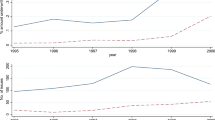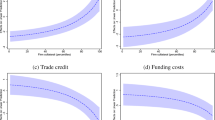Abstract
The Gramm–Leach–Bliley (GLB) Act of 1999 repealed many provisions of the Glass–Steagall Act that curtailed competition between banks and commercial firms. Significantly, however, the GLB Act did not repeal the constraint on banks from owning equity in commercial firms (“universal banking”). Should banks be allowed to hold equity in corporate borrowers? If allowed, would banks optimally choose to do so? Despite its relevance from a policy perspective, there are surprisingly few theoretical analyses of this issue of “universal banking”. We develop a model in which the bank's advisory role as an “inside” shareholder hinges on its equity stake. The optimal capital structure and the bank's and entrepreneur's equity stakes are endogenously determined in a world with potential double-sided moral hazard. In certain scenarios, the bank may prefer not to hold any equity. Our analysis indicates that allowing optimal bank equity participation may foster improved corporate performance. This benefit of universal banking should be considered in policy debates.
Similar content being viewed by others
References
Abegglen, J., and G. Stalk. Kaisha: The Japanese Corporation. New York: Basic Books, 1985.
Aoki, M. “Towards an Economic Model of the Japanese Firm.” Journal of Economic Literature 28 (1990), 1–27.
Berlin, M., K. John, and A. Saunders. “Bank Equity Stakes in Borrowing Firms and Financial Distress.” The Review of Financial Studies 9,no. 3 (1996), 889–919.
Berlin, M., and L. Mester. “Debt Covenants and Renegotiation.” Journal of Financial Intermediation 2 (1992), 95–133.
Besanko, D., and G. Kanatas. “Credit Market Equilibrium with Bank Monitoring and Moral Hazard.” The Review of Financial Studies 6,no. 1 (1993), 213–232.
Bhattacharya, S., and F. Lafontaine. “Double-Sided Moral Hazard and Nature of Share Contracts.” The Rand Journal of Economics (1995), 761–782.
Bhattacharya, S., and A. Thakor. “Contemporary Banking Theory.” Journal of Financial Intermediation 3 (1993), 2–50.
Blinder, A. “More Like Them.” Prospect (Winter 1992), 51–62.
Boyd, J., C. Chang, and B. Smith. “Moral Hazard Under Commercial and Universal Banking.” Journal of Money Credit and Banking 30,no. 3 (1998), 426–468.
Cantillo, M. “The Rise and Fall of Bank Control in the United States: 1890–1939.” American Economic Review 88,no. 5 (1998) 1077–1093.
Carey, M. “Are Bank Loans Mispriced?” Working paper, Board of Governors of the Federal Reserve System, 1995.
Chan, Y.-S., S. Greenbaum, and A. V. Thakor. “Is Fairly Priced Deposit Insurance Possible?” Journal of Finance 47,no. 1 (1992), 227–245.
Coffee, J. “Liquidity versus Control: The Institutional Investor as Corporate Monitor.” Columbia Law Review 6 (1991), 1277–1368.
DeLong, B. “Did J. P. Morgan's Men Add Value? An Economist's Perspective on Financial Capitalism.” In: P. Temin, ed., Inside the Business Enterprise: Historical Perspectives on the Use of Information. Chicago: University of Chicago Press for NBER, 1991, pp. 205–236.
Diamond, D. “Financial Intermediation and Delegated Monitoring.” Review of Economic Studies 51 (1984), 393–414.
Diamond, D. “Monitoring and Reputation: The Choice between Bank Loans and Directly Placed Debt.” Journal of Political Economy 99 (1991), 689–721.
Diamond, D. “Seniority and Maturity of Bank Loans and Directly Placed Debt.” Journal of Financial Economics 33 (1993), 341–368.
Giammarino, R., T. Lewis, and D. Sappington. “An Incentive Approach to Banking Regulation.” Journal of Finance 48,no. 4 (1993), 1523–1542.
Gorton, G., and J. Kahn. “The Design of Bank Loan Contracts, Collateral and Renegotiations.” Working paper, University of Pennsylvania, 1993.
Gorton, G., and F. Schmid. “Universal Banking and the Performance of German Firms.” NBER Working paper, University of Pennsylvania, 1996.
Grundfest, J. “Subordination of American Capital.” Journal of Financial Economics 27 (1990), 89–116.
Hellmann, T., K. Murdock, and J. Stiglitz. “Liberation, Moral Hazard in Banking, and Prudential Regulation: Are Capital Requirements Enough?” The American Economic Review 90 (2000), 147–165.
Hoshi, T., A. Kashyap, and D. Scharfstein. “The Role of Banks in Reducing the Costs of Financial Distress in Japan.” Journal of Financial Economics 27 (1990), 67–88.
Hoshi, T., A. Kashyap, and D. Scharfstein. “Corporate Structure, Liquidity, and Investments: Evidence from Japanese Industrial Groups.” Quarterly Journal of Economics 106 (1991), 33–60.
James, C. “When Do Banks Take Equity? An Analysis of Bank Loan Restructurings and the Role of Debt.” Working paper, University of Florida, 1993.
Jensen, M., and W. Meckling. “Theory of the Firm: Managerial Behavior, Agency Costs and Ownership Structure.” Journal of Financial Economics 3 (1976), 306–360.
Jensen, M. “Eclipse of the Public Corporation.” Harvard Business Review 5 (1989), 61–75.
Kaplan, S., and B. Minton. “Appointments of Outsiders to Japanese Boards: Determinants and Implications for Managers.” Journal of Financial Economics 36 (1994), 225–258.
Kester, W. Carl. Japanese Takeovers: The Global Contest for Corporate Control. Boston, MA: Harvard Business School Press, 1991.
Kim, S. “Corporate Financing Through a Shareholder Bank: Lessons from Japan.” Working paper PB92–03, Federal Reserve Bank of San Francisco, 1992.
Krainer, J. “The Separation of Banking and Commerce.” Economic Review, Federal Reserve Bank of San Francisco (2000), 15–25.
Leland, H., and D. Pyle. “Information Asymmetries, Financial Structure, and Financial Intermediaries.” Journal of Finance 32,no. 2 (1977), 371–387.
Mazumdar, S., and S. Yoon. “Loan Monitoring, Competition and Socially-Optimal Bank Regulations.” Journal of Risk and Insurance 63,no. 2 (1996), 279–312.
Morck, R., and M. Nakamura. “Banks and Corporate Control in Japan.” Journal of Finance 54 (1999), 319–339.
Nakatani, I. “The Economic Role of Financial Corporate Grouping.” In: M. Aoki, ed., Economic Analysis of the Japanese Firm. New York, NY: Elsevier, 1984.
Porter, M. “Capital Disadvantage: America's Failing Capital Investment System.” Harvard Business Review (September–October 1992), 65–83.
Pozdena, R. “Why Banks Need Commerce Powers.” Economic Review, Federal Reserve Bank of San Francisco, 18–30.
Prowse, S. “Institutional Investment Patterns and Corporate Financial Behavior in the U.S. and Japan.” Journal of Financial Economics 27 (1990), 43–66.
Prowse, S. “The Structure of Corporate Ownership in Japan.” Journal of Finance 47 (1992), 1121–1140.
Rajan, R. “Insiders and Outsiders: The Choice Between Relationship and Armslength Debt.” Journal of Finance 47 (1992), 1367–1400.
Ramakrishnan, R., and A. V. Thakor. “Information Reliability and a Theory of Financial Intermediation.” Review of Economic Studies 51 (1984), 415–432.
Welch, I. “Why Is Bank Debt Senior? A Theory of Asymmetry and Claim Priority Based on Influence Costs.” The Review of Financial Studies 10,no. 4 (1997), 1203–1236.
Yoon, S., and S. C. Mazumdar. “Fairly Priced Deposit Insurance, Incentive Compatible Regulations and Bank Asset Choices.” Geneva Papers on Risk and Insurance Theory 21,no. 1 (1996), 123–141.
Author information
Authors and Affiliations
Rights and permissions
About this article
Cite this article
Banerji, S., Chen, A.H. & Mazumdar, S.C. Universal Banking Under Bilateral Information Asymmetry. Journal of Financial Services Research 22, 169–187 (2002). https://doi.org/10.1023/A:1019776908768
Issue Date:
DOI: https://doi.org/10.1023/A:1019776908768




